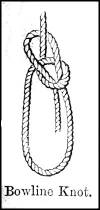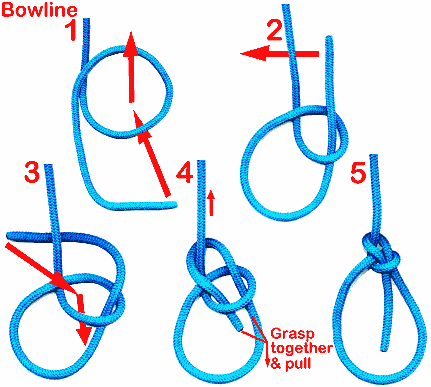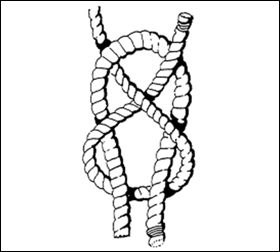Table of Contents
Knotwork
Initial article begun 2014-12-06 by Bill Blondeau
Basic concepts and terms
"Line" vs "Rope"
A piece of working rope is called a line. When you are talking about knots, you talk in terms of line.
Why do we say “line” instead of “rope”?
- Because knots are tied in string, twine, yarn, thread, cords, cloth or leather strips, etc, and you sound stupid referring to some of those things as “rope”. “Line” is a usefully generic term that covers all of these things impartially.
- Because “rope” has its own set of meanings. “Rope” is used in contexts where you are talking about a particular kind of line: its construction (twisted, braided, plaited, etc) or the material of which it’s made (nylon, hemp, jute, dacron, polypropylene, etc.)
One interesting thing: you do not use “line” to refer to steel cables, because there’s no effective way of knotting metal ropes. Flexible metal lengths have a completely different set of fastening techniques, involving attaching shackles to fixed eyes. Nothing in this article should be taken to apply to metal ropes: working with those is a different discipline.
the Working End and the Standing Part
Whenever you're working with a line, you have two different contexts. Or parts. Or existential natures. Or if you're a math geek, two topological aspects. Or… OK whatever.
- The end, or working end, is probably almost exactly what you think it is.
- The standing part is the rest of the line, stretching off to somewhere that you either don't care about or can't get to.
It's important to know these terms because they show up in almost any discussion of knots.
Classification of knots
There are three classifications of knots
- Knots A knot is a fastening in which a piece of rope is tied to itself. Examples include a bowline, or any sort of stopper knot. Unfortunately, the term “knot” is also used generically for the other classifications by the less informed.
- Hitches A hitch is a fastening in which a line is tied to something else, like a post or a ring. An example is a clove hitch a round turn with two half-hitches.
- Bends A bend is a fastening in which a line is tied to another line, typically to extend it. Examples include the sheet bend, or the figure 8 follow through, which is far stronger and less likely to slip than a sheet bend.
What are you tying it to?
Interestingly, this is one of the key categorizations of knots. What you're tying it to tends to drive the structural characteristics of the knot, and the methods used to tie it.
Knots can be tied to:
- The line itself, forming a loop or stopknot (aka “stopper”).
- The other end of the line; this is a binding knot. Binding knots are monstrously convenient because they are usually “snuggable” (you can tighten them up before finishing them), but they are dangerous because it’s tempting to misuse them. We get accustomed to tying binding knots all the time, and then we find ourselves using them without thinking about it.
- Another line: a knot that joins two lines so that they can handle a strain is called a bend. Only certain knots are referred to as “bends”; this is a practice based in the safety implications of using a different knot when a bend is required. If it doesn’t have “bend” in the name, don’t use it as a bend unless you’re damn sure it’s proper to do so. Safety: don’t join two lines for taking a strain with anything other than a proper bend. Joining two lines with a square knot (which is a binding knot, not a bend at all) has probably killed or injured more people than any other knotwork mistake.
- A post or hook (a rigid structure in which you have the option of passing a bight of line over the end). This kind of knot is called a hitch.
- A spar or ring (a rigid structure in which you do not have access to the end). This is also called a hitch; it just requires different methods of making the hitch.
The essential working knots
Everybody has opinions about this. Twelve different people who know something about knots would probably come up with twelve different lists. Some would say there are 4 essential knots, some would say 7. Or 13. Or 5. And some people would fly into sputtering indignation because some knot they can't imagine living without didn't make the cut. FOR THE LOVE OF GOD, WHERE IS THE TIMBER HITCH???
Here's the Bodgerous list of six. It's based on simple day-to-day practicality, including ease of use and safety.
- Bowline: a loop that won’t slip. Pronounced “BO-lun” in case you were wondering.
- Figure Eight: Basic safe stopknot, used in rigging work of any kind. Or to keep the thread from slipping back out of the needle's eye.
- Sheet Bend: the go-to bend for joining two line ends, especially if they are of different size.
- Square (or Reef) Knot: The basic binding knot.
- Round turn and two half hitches: the basic non-slippable hitch.
- Clove Hitch: a slippable hitch on a round spar
Here's specific info on these.
The Bowline
 | This knot forms a loop that tends not to slip. (Any knot can slip given a frictionless rope; bowlines are simple and strongly resist slipping when your line is a normal rope not lubricated with some external substance.) The bowline, for what it's worth, is the knot that's most likely to save your life. There are many kinds of bowline, with different puposes and properties. We are only going to look at the essential, basic bowline right now. |
Virtues
- Easy to learn
- Easy to see if correct
- Quick to tie
- Can tie one-handed
- Can tie without looking (in the dark, behind your back, etc)
- Won’t slip
- The loop will not tighten under load
- Easy to release - won’t jam
Disadvantages
- Can’t tie under load (you need a slack standing part in order to tie a bowline).
- Will shake loose (“shake loose” means line is slack and jostling around, which can work the knot until it comes undone.) Some knots are fairly shakeproof; the bowline is not one of them. In general, plan to use a bowline when the line will remain reliably under tension during the work you’re doing.
- Can capsize under heavy load. This can be a safety issue.
When to use
A non-slip loop has so many uses. As you learn and use the bowline, you’ll naturally come to rely on it more and more. Some particular things to think about:
- Hoisting a load. This is a particularly perfect fit:
- You typically begin with a slack line.
- The bowline’s loop can be passed through a shackle, around the body of the load, etc, before tying.
- Once the load is up, the line remains under tension for as long as the lift is happening.
- Once you’re done, the bowline can generally be released without difficulty.
- Hoisting a (conscious) human. Climbers and tall ship sailors both know this very well. If you tie a bowline around your body, the folks up above can hoist - and the line won’t tighten and crunch your chest or hips.
- Load tiedown. If you need a binding knot around something and you need to make it really tight, you can build a cheap and easy equivalent of a trucker’s hitch by putting a bowline in one end. Passing the other end through the bowline’s loop gives you a rough 2:1 mechanical advantage; once tight, the working end can be secured with two half hitches. Some obvious shortcomings here include very rapid rope wear; use with caution.
- A bowline’s loop can be used to make a catspaw (on a hook) or an attachment point for a lark’s head (which is a simple, secure kind of hitch).
Other bowlines
The simple bowline is not the most secure variant of the bowline family of knots. You can find safer variants of the bowline. Some of them are easy, some are not; but this list has been put together for day-to-day use. If you're a commercial fisherman or a mountaineering guide, and you are checking this list for knotwork basics, may Cthulhu eat you first (that's the closest Cthulhu comes to “having mercy on your soul”: when the Great Ones return, getting it over with quick is the best you can hope for.)
How to tie a bowline
The boring and awkward Boy Scout way:
This works. However, it is also the reason that so many people whine, “Bowlines are so hard”, and never use them much in real life. It is not a good way to learn the knot.

The Muscle Memory way:
(video forthcoming)
How to release a bowline
One of the best characteristics of a bowline is that you can release it easily, even after it’s been under a lot of strain. This is often called “popping” the bowline, or “breaking its back”. Popping a bowline cannot be done while under load. However, once the line is slack, popping it is simple: just go to the top of the knot and push it up along the standing part. It will introduce slack into the entire knot, and you’re good. Even a bowline in a hefty rope can be popped by pressing with both thumbs.
The Figure Eight
The Sheet Bend
 | This is the classic bend. It’s simple to learn, not easy to screw up, and is pretty good for normal usage. Learn it, use it, you won’t be disappointed. That said, if you need to manage very heavy loads or big ropes, it’s much safer and smarter to study up on a more advanced bend, such as the double carrick bend. These advanced knots are beyond the scope of this document. Looking at a sheet bend, you will probably notice similarities with the structure of the bowline. These similarities are not accidental. The virtues of both knots come from the same kinds of structural advantages. |
Virtues
- Simple.
- Very good for joining two lines when one is larger (or less flexible) than the other.
- Strong under load.
- Quick to tie.
- Won’t jam.
Disadvantages
- Can work loose if the joined lines are shaking while not under load.
- If the two ends do not end up on the same side of the knot, it’s insecure and will slip. (This is the only real exception to the “not easy to screw up” part.)

- Not suitable for really large ropes or industrial-strength haulage.
When to use it
- For general usage anytime you need to join two lines together.
- In fiber work (another name for the sheet bend is the “weaver’s knot”):
- Join two broken ends of yarn back together.
- Append a new skein to your work.
- Excellent for using a light line to pull the end of a heavy line across a gap:
- Lifting a heavy line to a high place for rigging.
- Crossing a chasm while mountaineering.
- Sending a mooring line to the pier from a ship that’s docking.
How to tie
This video is kind of nice because it shows it once quickly, once slowly. https://www.youtube.com/watch?v=x3reZ3NuGaQ
How to release
Once the load is off, it's pretty easy to see how to release the knot. Sheet bends are comparatively jam-resistant, and the technique for releasing them is similar to what you'd do with a bowline.
The Double Sheet Bend
For increased security, and as a general rule when one of the lines is considerably smaller or slinkier than the other, throw an extra wrap around the bend in the bigger line. It’s pretty easy to see how, and to understand why, by inspection. If in doubt about how to do it, see this video.
